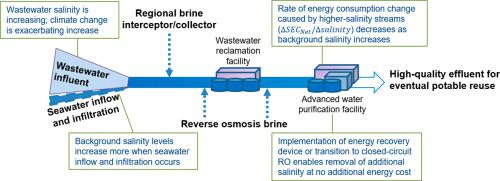Desalination ( IF 9.9 ) Pub Date : 2021-09-08 , DOI: 10.1016/j.desal.2021.115316 Xin Wei 1 , Kelly T. Sanders 1 , Amy E. Childress 1

|
With reverse osmosis membranes being industry-standard in many potable reuse facilities, an opportunity exists to desalinate higher-salinity streams (e.g., brine and regional brine interceptor streams) to augment traditional wastewater supplies and reduce brine disposal requirements. This study evaluates the energy consumed in recovering water from these streams at advanced water purification facilities. Scenarios without and with seawater inflow and infiltration at coastal wastewater reclamation facilities are considered. It was found that as wastewater salinity increases with increasing seawater inflow and infiltration, base case energy consumption increases, but the percent increase of energy consumption caused by mixing higher-salinity streams decreases. Multiple energy-saving strategies were evaluated, including energy recovery devices, closed-circuit reverse osmosis, and desalination of the higher-salinity streams separately from the treated wastewater. The energy savings was greater for closed-circuit reverse osmosis than for energy recovery devices and increased for both as influent salinity increases. The energy savings from desalinating higher-salinity streams separately increased as the salinity difference between the two streams increased. Addition of higher-salinity streams was also considered within the context of inorganic scaling potential, product water requirements, and discharge permits that may limit recoveries.
中文翻译:

回收盐度增加的废水用于饮用水再利用:反渗透海水淡化过程中的水回收和能源消耗
由于反渗透膜已成为许多饮用水再利用设施的行业标准,因此存在对高盐度流(例如盐水和区域盐水截流器流)进行脱盐以增加传统废水供应并减少盐水处理要求的机会。本研究评估了在先进的水净化设施中从这些溪流中回收水所消耗的能源。考虑了沿海废水回收设施没有和有海水流入和渗透的情况。结果表明,随着海水流入和渗透的增加,废水盐度增加,基本情况下的能耗增加,但混合高盐度水流引起的能耗增加百分比下降。评估了多种节能策略,包括能量回收装置、闭路反渗透,以及与处理过的废水分开的高盐度流的脱盐。与能量回收装置相比,闭路反渗透的节能效果更大,并且随着进水盐度的增加,两者都增加了。随着两个水流之间盐度差异的增加,分别对高盐度水流进行脱盐所节省的能源也增加了。在无机结垢潜力、产品水要求和可能限制回收率的排放许可的背景下,还考虑了添加更高盐度的流。与能量回收装置相比,闭路反渗透的节能效果更大,并且随着进水盐度的增加,两者都增加了。随着两个水流之间盐度差异的增加,分别对高盐度水流进行脱盐所节省的能源也增加了。在无机结垢潜力、产品水要求和可能限制回收率的排放许可的背景下,还考虑了添加更高盐度的流。与能量回收装置相比,闭路反渗透的节能效果更大,并且随着进水盐度的增加,两者都增加了。随着两个水流之间盐度差异的增加,分别对高盐度水流进行脱盐所节省的能源也增加了。在无机结垢潜力、产品水要求和可能限制回收率的排放许可的背景下,还考虑了添加更高盐度的流。


























 京公网安备 11010802027423号
京公网安备 11010802027423号